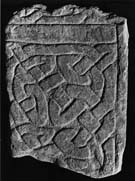Select a site alphabetically from the choices shown in the box below. Alternatively, browse sculptural examples using the Forward/Back buttons.
Chapters for this volume, along with copies of original in-text images, are available here.
Object type: Part of cross-shaft and -head
Measurements: H. 33.6 cm (13.25 in); W. 24.1 cm (9.5 in) D. 14.4 cm (5.75 in)
Stone type: Medium-grained, bedded, micaceous sandstone
Plate numbers in printed volume: Pls. 159.828-829, 160.830-831
Corpus volume reference: Vol 1 p. 166
(There may be more views or larger images available for this item. Click on the thumbnail image to view.)
A (broad): Parts of two panels of interlace subdivided by a flat-band moulding and with part of a similar edge moulding. (i) Only the bottom strands survive; they, like the lower panel, are constructed in outline in punched and grooved technique. The remains of the interlace are consistent with the pattern in the lower panel. (ii) One complete and one half register of pattern C with circling outside strands.
B (narrow): The remains of four registers of interlace of varying depth set within a flat-band moulding. The interlace is lightly grooved. All the registers have outside strands, and all are variations of pattern F: the terminal has combined E and F loops; then simple pattern F with outside strands; then two closed circuit surrounded F eIements with outside strands. There are traces of an offset at the top of the frame, and above is part of the lower cross-arm, which is plain within flat-band mouldings.
C (broad): This side seems to have had the same format as A, although only one register of pattern C with outside strands, and the upper border, survive.
D (narrow): Chiselled away.
This is a finer stone than some of the Bothal fragments, and although the technique is grooved, there is an understanding of interlace principles. The pattern is closely linked to Alnmouth and Lindisfarne 2.



